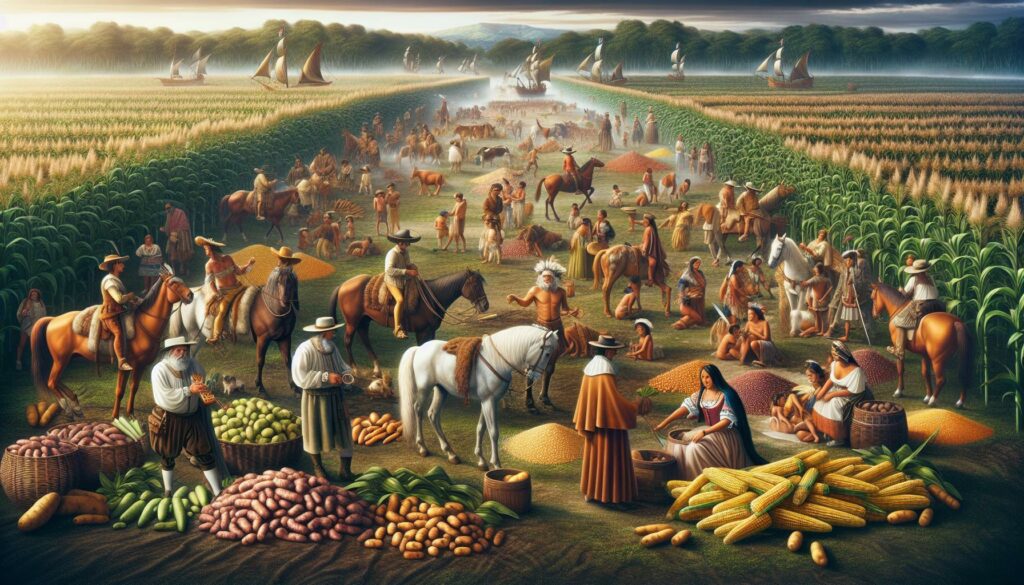The Columbian Exchange transformed the world in ways we’re still uncovering today. This fascinating exchange of goods, ideas, and cultures between the Old World and the New World not only reshaped economies but also altered diets and lifestyles across continents. I find it intriguing how a simple drawing can encapsulate such a monumental historical event.
In this article, I’ll explore the significance of Columbian Exchange drawings, highlighting their role in visualizing this complex interaction. These illustrations serve as powerful reminders of the interconnectedness of our global community, revealing the impact of trade and exploration. Join me as we delve into the artistic representations that tell the story of this pivotal moment in history.
Key Takeaways
- Historical Significance: The Columbian Exchange marked a transformative period of ecological and cultural interactions between the Old World and the New World, affecting economies, diets, and lifestyles.
- Visual Representation: Drawings serve as vital tools for visualizing the complexities of the Columbian Exchange, showcasing the transfer of crops, livestock, and cultural exchanges across continents.
- Educational Value: Illustrations enhance understanding by simplifying intricate topics, making history accessible and engaging for learners of all levels, encouraging critical discussions about trade and cultural dynamics.
- Influential Artists: Notable artists like Albrecht Dürer and Theodore de Bry contributed significantly to the visual narrative, capturing the essence and implications of the Columbian Exchange through their works.
- Themes and Symbols: Common themes in Columbian Exchange drawings include agricultural innovations, the impact of diseases on indigenous populations, and the cultural interactions that arose from these exchanges.
- Modern Relevance: These drawings provide modern audiences with insights into historical events, preserving the interconnectedness of global cultures and the implications of trade that continue to resonate today.
Columbian Exchange Drawing
The Columbian Exchange represents a significant period of ecological and cultural transformation between the Old World and the New World. Initiating in the late 15th century, it involved the transfer of plants, animals, diseases, and technologies. These exchanges facilitated unprecedented demographic shifts and diverse agricultural practices.
Key Components of the Columbian Exchange
- Flora: Crops like maize, potatoes, and tomatoes traveled from the Americas to Europe, enhancing diets and agricultural practices.
- Fauna: Livestock such as horses, cattle, and pigs were introduced to the Americas, impacting transportation and agriculture.
- Diseases: European diseases, including smallpox and influenza, significantly affected indigenous populations, leading to widespread mortality.
- Technological Innovations: The introduction of new farming techniques and tools improved productivity in both hemispheres.
Impact on Societies
The Columbian Exchange altered economies and lifestyles globally. European nations benefitted from new resources and agricultural abundance, while indigenous cultures faced dramatic population declines and social upheaval. These interactions laid the foundation for globalization, connecting distant continents and cultures in a profound way.
Visual Representations
Drawings associated with the Columbian Exchange illustrate these complex interactions. They depict the transfer of crops and livestock, the spread of diseases, and the overall cultural exchange. Such illustrations serve as visual narrations of this historical phenomenon, offering insights into the experiences of various societies during this era.
Importance Of Columbian Exchange Drawings
Columbian Exchange drawings play a crucial role in understanding the historical context and impact of this significant event. These illustrations offer visual insights into the complex interactions between the Old and New Worlds.
Visual Representation Of Historical Events
Visual representation captures the essence of the Columbian Exchange, showcasing the transfer of crops, animals, and ideas. Drawings depict elements such as maize, potatoes, and livestock, illustrating their journey across oceans. They provide a snapshot of the cultural exchanges that took place, highlighting the diversity of products and practices that emerged. Graphic depictions allow for a more profound understanding of how these exchanges altered societies and environments.
Educational Value Of Illustrations
Illustrations serve as powerful educational tools. They facilitate comprehension of the intricate relationships formed during the Columbian Exchange by translating complex concepts into easily digestible visuals. Such visuals engage learners at various levels, making historical information more accessible. They also foster critical thinking, prompting discussions about the implications of these exchanges on global trade and cultural dynamics. Additionally, illustrations encourage exploration into topics like agriculture, disease, and colonization, enriching classroom learning and personal inquiry.
Analysis Of Key Columbian Exchange Drawings
Columbian Exchange drawings play a crucial role in communicating the profound implications of this historical event. These illustrations encapsulate themes, symbols, and contributions from various artists, offering insights into the Exchange’s impact.
Notable Artists And Their Contributions
Several artists significantly contributed to the visual representation of the Columbian Exchange.
- Albrecht Dürer: Known for his detailed engravings, Dürer’s work often highlighted the interplay of European and New World species, shaping perceptions of exotic flora and fauna.
- Johann Moritz Rugendas: Rugendas captured the agricultural practices and landscapes of Latin America, providing an in-depth view of the new crops introduced through the Exchange.
- Theodore de Bry: De Bry’s prints depicted encounters between Europeans and indigenous populations, emphasizing the cultural exchanges and changes brought by colonization.
These artists utilized their talents to document, interpret, and convey the complexities of the Columbian Exchange through their works, enriching our understanding of this significant historical transformation.
Common Themes And Symbols
Columbian Exchange drawings convey several common themes and symbols that reflect the event’s essence.
- Agricultural Exchange: Plants such as maize and potatoes symbolize the agricultural innovations stemming from the Exchange, highlighting shifts in diets and farming practices.
- Impact of Disease: Illustrations often depict the devastating effects of European diseases on indigenous populations, serving as a grim reminder of the Exchange’s darker aspects.
- Cultural Interaction: Many drawings showcase the mingling of cultures through trade, emphasizing mutual influence and adaptation between the Old and New Worlds.
These themes and symbols help in understanding the multifaceted consequences of the Columbian Exchange, connecting visual representation with historical narrative and human experience.
Impact Of Columbian Exchange Drawings On Modern Understanding
Columbian Exchange drawings significantly enhance modern understanding of historical interactions. These illustrations serve as visual documentation, illustrating the vast exchanges that reshaped global ecosystems and cultures. They bridge the gap between complex historical narratives and accessible visual expressions, facilitating a deeper comprehension of the Columbian Exchange’s implications.
Various artists, such as Albrecht Dürer and Theodore de Bry, captured the complexities of the Exchange in their works. Their illustrations depict the introduction of crops, livestock, and technologies, as well as the spread of diseases. Each drawing conveys essential themes, such as agricultural transformations, the impact of disease on indigenous populations, and cultural exchanges between disparate peoples.
Drawings also act as educational tools, making intricate concepts more approachable. Visual representations resonate with diverse learners, allowing them to grasp the historical significance and engage critically with the material. Classroom settings benefit enormously from these illustrations, as they stimulate discussions around colonization, trade, and ecological shifts.
Furthermore, Columbian Exchange drawings participate in a broader discourse on globalization. They highlight interconnectedness, demonstrating how local changes can influence global trends. By examining these visuals, individuals develop a greater appreciation for the historical context, the effects of trade, and the cultural interactions that shape our contemporary world.
The influence of Columbian Exchange drawings on modern understanding is profound. They preserve history, clarify complex issues, and provide entry points for further exploration into this pivotal era of human interaction.



